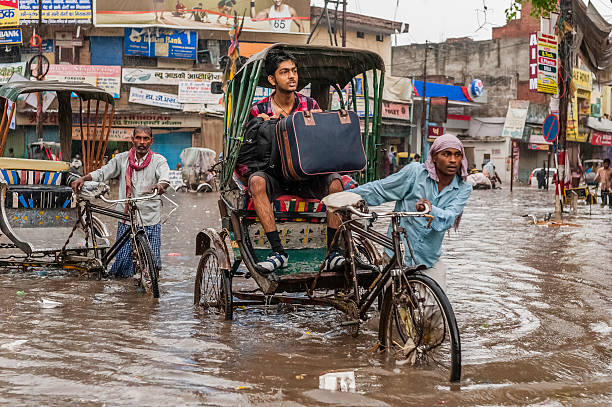1. Introduction: The 2025 Flooding in India — A National Emergency Unfolds
The year 2025 has marked one of the most devastating instances of flooding in India in recent decades. From the northern states of Uttarakhand and Himachal Pradesh to the eastern floodplains of Bihar and Assam, vast regions have been submerged under water. Millions have been affected, thousands displaced, and infrastructure severely damaged. This crisis has reignited urgent discussions around India’s preparedness for increasingly intense natural disasters, especially those linked to changing climate patterns.
Flooding in India is not new, but the scale and frequency witnessed in 2025 are unprecedented. The national capital faced waterlogging, remote villages were cut off, and major rivers like the Ganga and Brahmaputra breached their danger marks repeatedly. Experts warn that this year’s catastrophe was not an isolated event but a glimpse into a future where climate-driven extreme weather becomes the new normal. Understanding the causes behind this year’s flooding is key to preventing even worse disasters.
2. A Record-Breaking Monsoon: Unusual Rainfall Patterns in 2025
The 2025 monsoon season saw record-breaking rainfall across much of the Indian subcontinent. Some regions recorded up to 40% more rainfall than the annual average, leading to widespread flash floods and river overflows. The erratic nature of these monsoon rains with dry spells followed by intense cloudbursts overwhelmed traditional water management systems and flooded even low-risk zones.
This unpredictable rainfall pattern is closely linked to shifts in the Indian Ocean Dipole and El Niño effects, both of which influenced the distribution and intensity of rainfall. The monsoon, traditionally a lifeline for Indian agriculture, turned into a disaster catalyst in 2025. It highlighted the urgent need for improved seasonal forecasting and climate-resilient infrastructure in high-risk flood zones.
3. How Climate Change Intensified Flooding in India This Year
Climate experts agree that climate change played a central role in worsening the 2025 flooding in India. Warmer air holds more moisture, leading to heavier rainfall events. Coupled with rising sea surface temperatures, this has resulted in stronger monsoons and sudden downpours that current drainage systems simply cannot handle.
Additionally, climate change is accelerating glacial melt in the Himalayas, leading to an increase in glacial lake outburst floods (GLOFs). These sudden releases of water from overfilled glacial lakes further contribute to flash flooding in northern states. The 2025 floods serve as a warning sign that India’s climate vulnerabilities are intensifying, and immediate adaptation strategies are needed.
4. From Rivers to Roads: Multiple Triggers Behind the Flooding in India
The 2025 crisis was not caused by one factor alone. It was a deadly combination of river overflow, intense rainfall, poor infrastructure, and unplanned urban expansion. Major rivers like the Ganga, Yamuna, Brahmaputra, and Godavari swelled beyond their banks, inundating thousands of villages and towns.
Simultaneously, even urban areas saw urban flooding due to blocked drains, encroachment on natural waterways, and outdated stormwater systems. Roads turned into rivers, and public transport collapsed in major metros. This year’s events made it clear that both rural and urban India are vulnerable and for different but interconnected reasons.
5. Flash Floods and Glacial Melts: The Hidden Threat in the Himalayas
In the Himalayan belt, flash floods triggered by glacial melt were among the most destructive events of 2025. Uttarakhand and Himachal Pradesh experienced sudden torrents caused by glacial lake outbursts, devastating mountain communities and sweeping away bridges and highways.
These high-altitude regions, once considered relatively insulated from monsoon flooding, are now emerging as new danger zones. Scientists attribute this to rapid glacial retreat due to global warming, forming unstable lakes that can collapse at any time. The 2025 floods have forced policymakers to focus on the fragile Himalayan ecosystem and its role in nationwide flood disasters.
6. Urban Flooding in India’s Major Cities: Is Infrastructure Failing Us?
Cities like Mumbai, Bengaluru, Chennai, and Delhi experienced severe urban flooding in 2025, paralyzing daily life. In many cases, the floods were not caused by excessive rainfall alone but by the failure of infrastructure. Choked drains, encroachments, and insufficient stormwater systems turned brief rains into long-term waterlogging.
As India urbanizes rapidly, its cities are becoming more vulnerable to climate-related disasters. The 2025 flooding exposed the gap between development and disaster resilience. Experts are now calling for climate-resilient urban planning, including the preservation of wetlands, better drainage design, and early warning systems tailored for urban areas.
7. State-Wise Breakdown: Most Affected Regions by the 2025 Flooding
In 2025, Bihar, Assam, West Bengal, Maharashtra, and Uttarakhand were among the worst-hit states. Assam witnessed its annual flood crisis escalate into a full-blown emergency, displacing over a million people. Meanwhile, parts of Maharashtra and Goa, not typically flood-prone, experienced record waterlogging due to unexpected rainfall.
This state-wise disparity shows how climate variability and local mismanagement are compounding the crisis. The flood-affected areas range from rural villages on riverbanks to bustling urban centers, underscoring the need for region-specific solutions. A national flood risk zoning strategy is long overdue.
8. Economic Toll of Flooding in India: Losses Beyond the Waterline
The economic cost of the 2025 flooding in India is estimated to exceed ₹1.5 lakh crore ($18 billion). Crops across thousands of hectares were destroyed, transport networks disrupted, and small businesses shut down. In flood-hit villages, livelihoods were washed away along with homes and farmlands.
Beyond immediate damage, long-term economic effects include inflation in food prices, job losses, and strain on state disaster funds. Insurance coverage in many regions remains low, increasing the financial vulnerability of flood-prone populations. The 2025 crisis is a wake-up call for economic preparedness and climate-smart agriculture.
9. Social Consequences: Displacement, Disease, and Education Disruption
Over 5 million people were displaced due to the 2025 flooding in India. Relief camps, though essential, were overwhelmed, raising concerns about hygiene, malnutrition, and disease outbreaks. In several regions, schools were converted into shelters, disrupting education for weeks or even months.
Women, children, and the elderly were particularly vulnerable. Reports of waterborne diseases like cholera, leptospirosis, and dengue surged in post-flood conditions. The floods have exposed deep social inequalities in disaster response, showing that resilience must also mean equitable and inclusive recovery planning.
10. Disaster Management and Government Response: Successes and Shortcomings
The National Disaster Response Force (NDRF) and state agencies were quick to act in many areas, deploying boats, helicopters, and relief supplies. However, the scale of the disaster revealed glaring gaps in coordination, local preparedness, and early warning systems. In some flood-hit areas, help arrived only after significant delays.
Government response varied widely by state. Some administrations were praised for proactive evacuations, while others struggled with poor communication and logistics. The 2025 flooding in India made it clear that disaster management must be decentralized, with better-trained local authorities and community-based resilience programs.
11. Technology and Early Warning Systems: Are We Doing Enough?
Despite improvements in weather forecasting, many regions in 2025 were caught off guard. Early warning systems did not reach vulnerable populations in time, or were not taken seriously due to poor past performance. This raises questions about the effectiveness of India’s flood prediction infrastructure.
Emerging technologies including AI-based flood modeling, satellite monitoring, and real-time alerts via mobile networks have shown promise but remain underutilized. The future of flood mitigation lies in making these tools widely accessible and integrating them with local governance and citizen participation.
12. Preventing the Next Disaster: Long-Term Solutions for Flooding in India
Flooding in India cannot be completely eliminated, but its impacts can be drastically reduced with smart, long-term planning. This includes restoring wetlands, reforesting river basins, investing in sustainable drainage systems, and enforcing building codes in urban and rural areas.
The 2025 floods should be treated not just as a disaster, but as an opportunity for systemic change. From climate adaptation policies to green infrastructure and environmental education, the country needs a shift in how it approaches flood risk. The next crisis is inevitable but its damage doesn’t have to be.





7kmbax